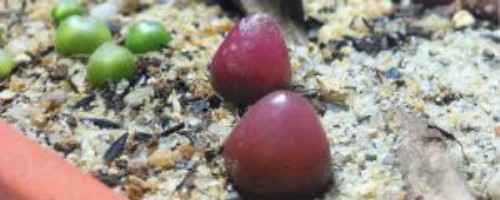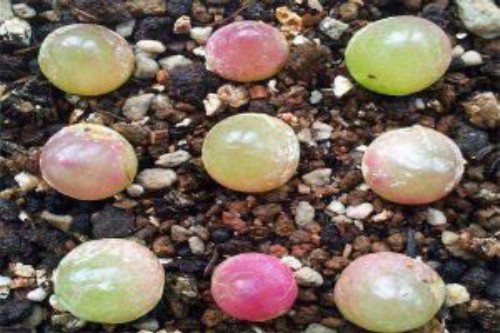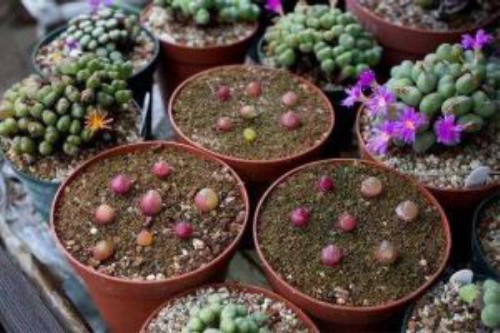Conophytum burgeri is a plant in the genus Conophytum burgeri. The plant has a bright green surface, translucent, suitable environment, with lavender flowers in spring or autumn. In the sun, the plants are slightly red, crystal clear and look shiny, like a glowing Conophytum burgeri, very beautiful.
Conophytum burgeri's scientific name is "Conophytum burgeri". It is a perennial succulent plant belonging to the Sarcocona family, native to the Namaqualand region of South Africa, because the whole plant looks like a small onion, so the name "Burger' "s onion" (Burger's onion). In addition, because its plant type is very similar to Japan's Mount Fuji, so it has the nickname of "Mount Fuji". The skin of the Conophytum burgeri can be bright green or pale yellow, and the surface may appear red under the influence of light and bugs.

Conophytum burgeri
Growing environment: Conophytum burgeri prefers cool, dry and sunny conditions. They should grow under the conditions of large temperature difference between day and night, not shade, drought resistance, avoid water, neither cold nor heat. Therefore, in the maintenance process, special attention should be paid to the control of temperature and light.
Watering: The Conophytum burgeri does not have a high need for water, and when watering, it is necessary to master the principle of "don't do it, don't pour it, then pour it through". During the growth period, it can be placed in a sunny place for maintenance, and water should be avoided when watering, so as not to crack the plant skin easily and affect the viewing. Water should be controlled during the summer dormant period, so that the water in the old skin evaporates, thinns, and adheres to the plant. During the peeling period, little or no water can be provided to allow the old skin to molt naturally.
Soil: The Conophytum burgeri soil needs to be loose, breathable, well drained and have a certain granularity. It can be prepared by mixing leaf soil or nutrient soil such as turf and peat with granular materials such as red jade soil or coarse sand, and adding a small amount of calcareous materials such as bone meal. In order to look beautiful and prevent plant rot, you can also spread a layer of stone or pottery on the surface of the basin soil.
Soil change: Conophytum burgeri requires an annual soil change treatment, which is recommended in spring and autumn. In the process of soil change, the roots of the plants need to be pruned and sterilized to ensure that the plants are quickly suitable.
Propagation: Conophytum burgeri is propagated by sowing and dividing. Sowing in the autumn, because the seeds are small, after sowing must cover the glass, watering should be used "Yin water" method. The two-headed or multi-headed Conophytum burgeri can be combined to change POTS and propagated by the division method.
Temperature and light: It is recommended to give Conophytum burgeri full sun maintenance in spring and autumn and winter to ensure the growth of the plant. Shade measures should be taken in summer to prevent damage to plants caused by strong light. The Conophytum burgeri can be moved indoors to a sunny place to maintain the indoor temperature at no less than 5 ° C in winter.
< img SRC = "https://pinduoduo.news/pic/20240424/5145.jpg" title = "Conophytum burgeri seed what kind of" Alt = "Conophytum How do you plant burgeri seeds? "style="text-wrap: wrap; width: 500px; height: 200px;" width="500" height="200" border="0" vspace="0"/>
Conophytum burgeri how to winter
Temperature control: Conophytum burgeri likes cool conditions, but in winter when the temperature is too low, it needs to keep the temperature of its growing environment at least 5 ° C. The Conophytum burgeri can be moved to a sunny part of the room, and if the indoor temperature is not up to the conditions, the option is to use hot-wire heating, succulent light, small heaters and other methods to maintain the right temperature conditions.
Watering management: The growth rate of the Conophytum burgeri slows down in the colder winter weather, so the frequency of watering needs to be reduced. It is recommended to water every half month to keep the soil dry. If the indoor air is not humid enough, it can be supplemented by an air humidifier or by spraying water on the Conophytum burgeri surface.
Light needs: The Conophytum burgeri needs plenty of sunlight for photosynthesis and healthy growth. Therefore, in the winter to try to put it in a sunny place, such as Windows and so on. If the indoor light is insufficient, you can use succulent light to supplement the light.
Ventilation management: Conophytum burgeri requires a well-ventilated environment to avoid pests and diseases. In winter indoor maintenance, pay attention to ventilation, but to avoid ventilation when the temperature difference is too large, so as not to cause damage to the plant.
Dry winter method: As we enter November, the water supply can be gradually reduced to keep the soil of the Conophytum burgeri dry. When the soil is completely dry, pull the Conophytum burgeri out of the pot, brush the soil off it, wrap it in a large paper bag, and place it in a small part of the house. In April of next year, it can be transplanted into the new soil.


Fujiyama
The skin of the Conophytum burgeri is bright green and translucent, with a red color during the summer dormant period and in a well-lit environment. The large flowers are lilac red and white in the center. They bloom in spring or autumn. Flowers open during the day, closed at night, if the cultivation environment is not enough light or rainy days, it is difficult to bloom.
The Conophytum burgeri is native to South Africa and has a distinct growth habit.
The Conophytum burgeri begins to grow in the fall, and in the winter and spring plants begin to grow in the body, usually only one new plant per plant. With the growth of the plant, the new plant inside gradually expanded, to achieve its own replacement.
In summer, the Conophytum burgeri enters a dormant phase where the surface dries up and wraps around the epidermis. Although not beautiful, but the outer layer of old leaves can protect the plant and absorb water, have a protective effect on the new plant. Autumn plants wake up, surface kraft paper like old leaves will automatically fall off, restore the crystal clear state.